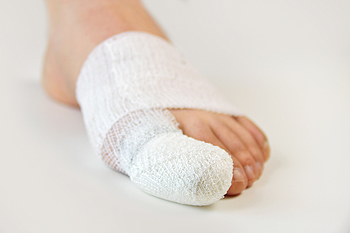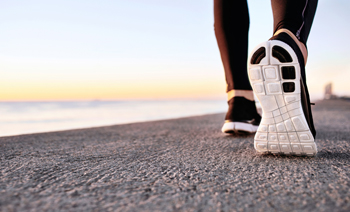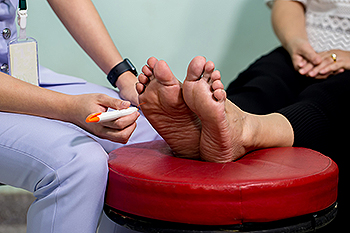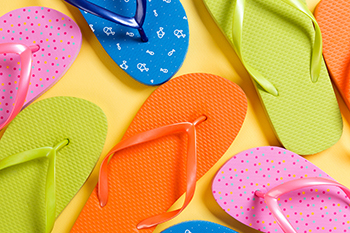Connect With Us
Blog
Items filtered by date: July 2022
Reducing and Recovering From Sports Injuries of the Toe

While toe injuries are usually not serious, they can seriously impede the progress of an athlete. If you participate in sports, it is critical that you wear the right shoes for the sport that you participate in. Watch for toe fractures by tending to the severity of the pain felt and possible swelling, looking for deformities of the toe or toenail and other possible wounds. If a toe is sprained and not broken, it can be buddy taped to the toe next to it to reduce pain and speed recovery. Doing some basic motion exercises might also help with blood flow, and reduce pain and stiffness. Toe injuries left untreated or unaddressed for too long could lead to stiffness, arthritis, or permanent pain long-term. Toe injuries sustained during sports that involve fractures or do not heal after resting for a period of time should be seen by a podiatrist for proper diagnosis and guidance in treatment.
Ankle and foot injuries are common among athletes and in many sports. They can be caused by several problems and may be potentially serious. If you are feeling pain or think you were injured in a sporting event or when exercising, consult with one of our podiatrists from Podiatry Inc.. Our doctors will assess your condition and provide you with quality foot and ankle treatment.
Common Injuries
The most common injuries that occur in sporting activities include:
- Achilles Tendonitis
- Achilles Tendon Rupture
- Ankle Sprains
- Broken Foot
- Plantar Fasciitis
- Stress Fractures
- Turf Toe
Symptoms
Symptoms vary depending upon the injury and in some cases, there may be no symptoms at all. However, in most cases, some form of symptom is experienced. Pain, aching, burning, bruising, tenderness, tightness or stiffness, sensation loss, difficulty moving, and swelling are the most common symptoms.
Treatment
Just as symptoms vary depending upon the injury, so do treatment options. A common treatment method is known as the RICE method. This method involves rest, applying ice, compression and elevating the afflicted foot or ankle. If the injury appears to be more serious, surgery might be required, such as arthroscopic or reconstructive surgery. Lastly, rehabilitation or therapy might be needed to gain full functionality in the afflicted area. Any discomfort experienced by an athlete must be evaluated by a licensed, reputable medical professional.
If you have any questions, please feel free to contact our offices located in Beachwood, Mayfield Heights, Mentor, and Tallmadge, OH . We offer the newest diagnostic and treatment technologies for all your foot care needs.
Differences Between Walking and Running Shoes

Countless Americans choose to get their daily dose of exercise and movement from walking and running. If you are one such person, it is imperative that you make yourself well acquainted with the critical differences between walking and running shoes. Despite the surface-level similarities between walking and running as activities, shoes for each activity are built differently to suit the differences between the activities. For example, running shoes have thicker and sturdier heel cushions than walking shoes. This is because the act of running requires putting more pressure and weight on the heel area of the foot. Running shoes also have wider heel cushions to provide the extra needed stability for runners. Additionally, running and walking shoes are different from each other because the former relies more heavily on having a sturdy mid-sole to essentially absorb the high impact running puts on the joints. Shock absorption is more important in running shoes because while running, individuals can put up to 200 pounds of weight impact onto their feet. You can use this information about the differences between walking and running shoes when shopping for both to know what features you should be on the lookout for. A podiatrist can help further clarify the differences and importance between these shoes.
For more information about walking shoes versus running shoes, consult with one of our podiatrists from Podiatry Inc.. Our doctors can measure your feet to determine what your needs are and help you find an appropriate pair of footwear.
Foot Health: The Differences between Walking & Running Shoes
There are great ways to stay in shape: running and walking are two great exercises to a healthy lifestyle. It is important to know that running shoes and walking shoes are not interchangeable. There is a key difference on how the feet hit the ground when someone is running or walking. This is why one should be aware that a shoe is designed differently for each activity.
You may be asking yourself what the real differences are between walking and running shoes and the answers may shock you.
Differences
Walking doesn’t involve as much stress or impact on the feet as running does. However, this doesn’t mean that you should be any less prepared. When you’re walking, you land on your heels and have your foot roll forward. This rolling motion requires additional support to the feet.
Flexibility – Walking shoes are designed to have soft, flexible soles. This allows the walker to push off easily with each step.
If you have any questions, please feel free to contact our offices located in Beachwood, Mayfield Heights, Mentor, and Tallmadge, OH . We offer the newest diagnostic and treatment technologies for all your foot care needs.
Foot Ulcers Can Be a Serious Complication of Diabetes

People who have diabetes are aware of the complications that can arise if proper foot care is not provided. Neuropathy, a condition that prevents feeling in the feet, may accompany diabetes. It is beneficial to check the bottom of the feet for existing cuts, bruises, or scrapes. Many patients ask a family member to help them look for cuts on the feet, or it may be done by using a mirror. Foot ulcers can be a common side effect of diabetes, and amputation may be necessary if ulcers are not treated promptly. The skin on the feet may change color in diabetic patients, and unusual sensations in the feet may be a symptom of nerve damage. Proper foot care starts with washing the feet regularly, trimming the toenails correctly, and wearing shoes that fit properly. Additionally, it can help to wear socks that are made of a cotton material, and it is beneficial to avoid activities that can injure the feet. When frequent foot exams are performed, the chances of noticing a cut is improved. Then treatment can begin in a timely fashion. If you are a diabetic patient, it is strongly advised that you are under the care of a podiatrist who can help you to manage this condition.
Diabetic foot care is important in preventing foot ailments such as ulcers. If you are suffering from diabetes or have any other concerns about your feet, contact one of our podiatrists from Podiatry Inc.. Our doctors can provide the care you need to keep you pain-free and on your feet.
Diabetic Foot Care
Diabetes affects millions of people every year. The condition can damage blood vessels in many parts of the body, especially the feet. Because of this, taking care of your feet is essential if you have diabetes, and having a podiatrist help monitor your foot health is highly recommended.
The Importance of Caring for Your Feet
- Routinely inspect your feet for bruises or sores.
- Wear socks that fit your feet comfortably.
- Wear comfortable shoes that provide adequate support.
Patients with diabetes should have their doctor monitor their blood levels, as blood sugar levels play such a huge role in diabetic care. Monitoring these levels on a regular basis is highly advised.
It is always best to inform your healthcare professional of any concerns you may have regarding your feet, especially for diabetic patients. Early treatment and routine foot examinations are keys to maintaining proper health, especially because severe complications can arise if proper treatment is not applied.
If you have any questions please feel free to contact our offices located in Beachwood, Mayfield Heights, Mentor, and Tallmadge, OH . We offer the newest diagnostic and treatment technologies for all your foot and ankle needs.
Reminder: When Was the Last Time...?
Flip Flops Can Be Fashionable but Harmful
As th e weather gets warmer and the summer season reaches its full stride, many individuals will slip on a pair of casual and seasonable flip-flops. Although flip-flops may seem like the perfect fashion statement for beach days and fun summer outings, wearing this kind of shoe for prolonged periods can yield detrimental consequences. Since one must constantly clench or tighten the toes to keep flip-flops from sliding off of the feet, wearing these shoes can negatively impact muscles in the feet and calves. Such muscular problems might even result in plantar fasciitis, causing pointed pains in the heels during physical activity such as running. Flip-flop use can create serious problems in other areas of the body including the knees. Experts recommend that flip-flops be worn for walking no more than relatively short distances. If one needs to walk more than this distance, a sandal with straps around the entire foot might prove to be a better option. Such sandals do not make the toes tighten to keep the shoe on the foot in the same way that flip-flops do. Regardless of the summer shoe you prefer, you might consider consulting with your podiatrist to ensure that your footwear choices are setting your feet up for success.
e weather gets warmer and the summer season reaches its full stride, many individuals will slip on a pair of casual and seasonable flip-flops. Although flip-flops may seem like the perfect fashion statement for beach days and fun summer outings, wearing this kind of shoe for prolonged periods can yield detrimental consequences. Since one must constantly clench or tighten the toes to keep flip-flops from sliding off of the feet, wearing these shoes can negatively impact muscles in the feet and calves. Such muscular problems might even result in plantar fasciitis, causing pointed pains in the heels during physical activity such as running. Flip-flop use can create serious problems in other areas of the body including the knees. Experts recommend that flip-flops be worn for walking no more than relatively short distances. If one needs to walk more than this distance, a sandal with straps around the entire foot might prove to be a better option. Such sandals do not make the toes tighten to keep the shoe on the foot in the same way that flip-flops do. Regardless of the summer shoe you prefer, you might consider consulting with your podiatrist to ensure that your footwear choices are setting your feet up for success.
Flip-flops are not always the best choice of footwear. If you have any concerns about your feet or ankles, contact one of our podiatrists from Podiatry Inc.. Our doctors will assist you with all of your foot and ankle needs.
Flip-Flops and Feet
When the weather starts warming up, people enjoy wearing flip-flops. Flip-flops are comfortable, stylish, and easy to slip on and off; they're perfect for any summer beach goer. However, these shoes can cause harm to the feet.
How Can Flip-Flops Affect Me Long-Term?
- Ankle problems
- Hip problems
- Lower back problems
- Pain in the balls of the feet
- Problems with foot arches
- Changes in the way you walk
Are There Injuries Associated with Flip-Flops?
Yes. Since flip-flops are relatively weak and do not provide the same amount of support as sneakers, people who wear flip-flops regularly are more susceptible to injuries. On top of that, the open nature of the shoe makes your feet more prone to other problems, such as cuts and even infections. Common injuries and ailments include:
- Sprained ankles
- Blisters
- Infections
- Cuts and Scrapes
I like Wearing Flip-Flops. Are There Safe Alternatives?
When buying flip-flops, try to find ones that have sturdy soles and that are made of high-quality materials that will support for your feet. These flip-flops will cost more but will also last longer as a result.
If you have any questions please feel free to contact our offices located in Beachwood, Mayfield Heights, Mentor, and Tallmadge, OH . We offer the newest diagnostic and treatment technologies for all your foot and ankle needs.

